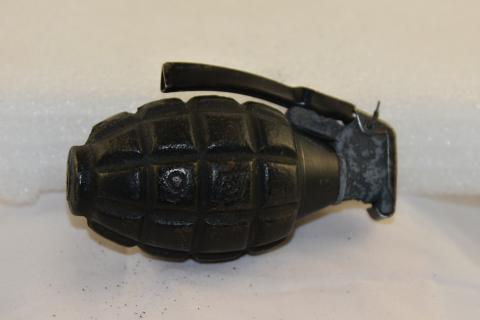This is an American Mk 1 grenade with a heavy metal outer casing with steel firing pin mechanism. The exterior of the grenade has been layered in a coat of black sealant which is likely not original to the item. The metal of the firing mechanism has corroded extensively and has a tendency to flake if handled aggressively. This kind of grenade was given to American troops in World War One as an anti-infantry fragmentation explosive to be primarily used in trench warfare. During the first year of U.S. involvement in the war, American soldiers had no fragmentation grenades of their own and would often have to borrow from the British and French. The Mk 1 was designed as the better alternative to the French F1 grenade, although several crippling design flaws cropped up early in its use. The Mk 1 was notoriously difficult to properly light in the field, resulting in American soldiers throwing scores of dud grenades at enemy lines. Enemy soldiers would often take these dud grenades and throw them back after properly lighting them, causing severe damage to American servicemen. In light of this and other design complications, the Mk 1 was pulled from service before the war's end. During World War Two, many Mk 1 grenades were defused and used as dummy explosives to train American soldiers. This content can be used with the following resources: SS.4.25: Technological Change The American MK1 hand grenade represents a significant advancement in the standard issue armaments of the United States Army. This content can help educate students about the impact that military technology advancement had on other aspects of history in the United States and Iowa in particular. For any use other than instructional resources, please check with the organization that owns this item for any copyright restrictions.
2018.002.013 [Grenade, Antipersonnel]
Legal Status
Copyright to this resource is held by the Iowa Masonic Library and Museum and has been provided here for educational purposes only, specifically for use in the Iowa Museum Association's "Teaching Iowa History" project. It may not be downloaded, reproduced or distributed in any format without written permission from the Rights Holder. For more information on U.S. and International copyright laws, consult an attorney.

